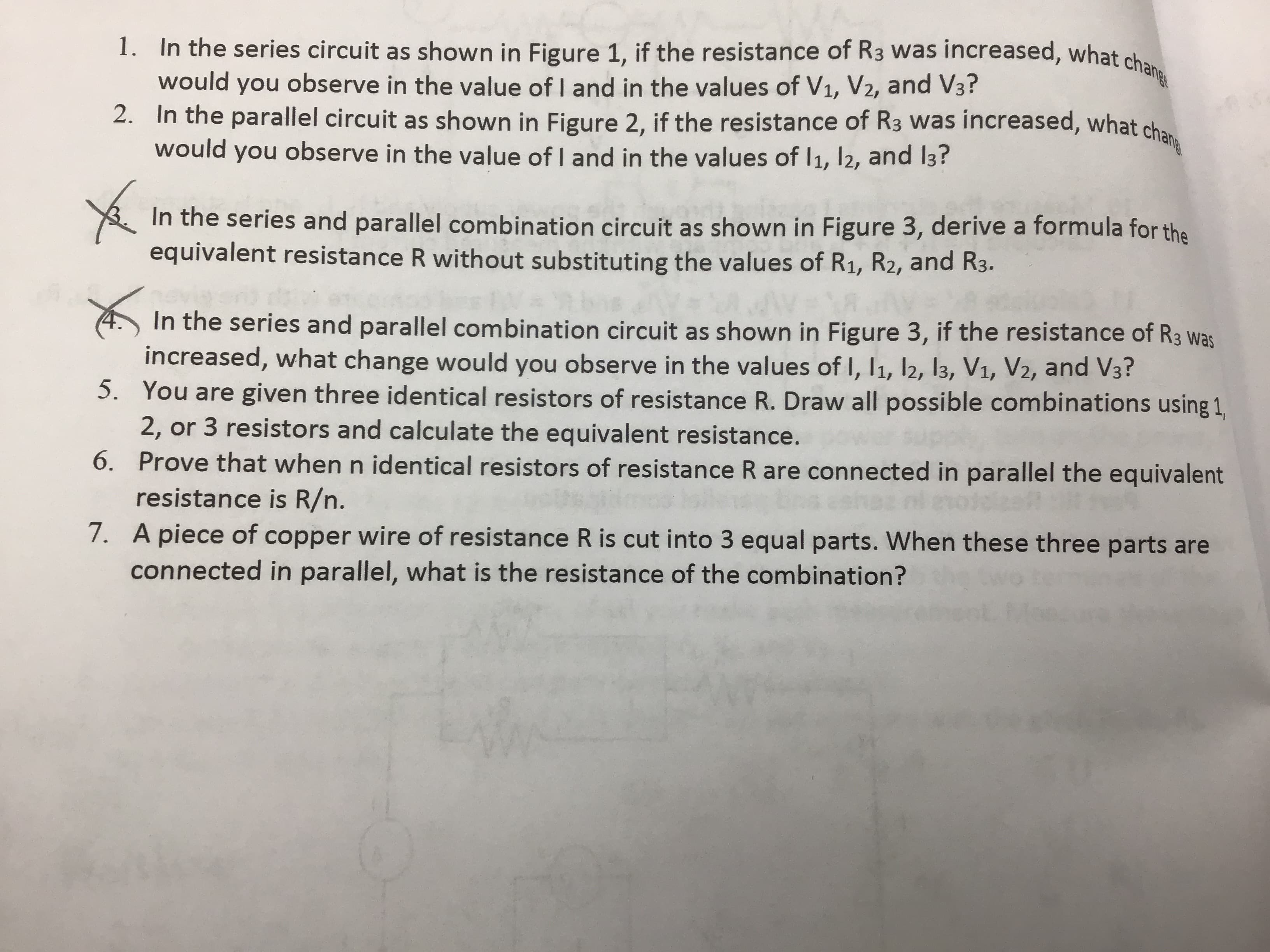1. In the series circuit as shown in Figure 1, if the resistance of R3 was increased, what chang would you observe in the value of I and in the values of V1, V2, and V3? 2. In the parallel circuit as shown in Figure 2, if the resistance of R3 was increased, what cha. would you observe in the value of I and in the values of I1, l2, and I3? In the series and parallel combination circuit as shown in Figure 3, derive a formula for the equivalent resistance R without substituting the values of R1, R2, and R3. In the series and parallel combination circuit as shown in Figure 3, if the resistance of R3 was increased, what change would you observe in the values of I, 11, l2, 13, V1, V2, and V3? 5. You are given three identical resistors of resistance R. Draw all possible combinations using 1, 2, or 3 resistors and calculate the equivalent resistance. 6. Prove that when n identical resistors of resistance R are connected in parallel the equivalent resistance is R/n. 7. A piece of copper wire of resistance R is cut into 3 equal parts. When these three parts are connected in parallel, what is the resistance of the combination?
1. In the series circuit as shown in Figure 1, if the resistance of R3 was increased, what chang would you observe in the value of I and in the values of V1, V2, and V3? 2. In the parallel circuit as shown in Figure 2, if the resistance of R3 was increased, what cha. would you observe in the value of I and in the values of I1, l2, and I3? In the series and parallel combination circuit as shown in Figure 3, derive a formula for the equivalent resistance R without substituting the values of R1, R2, and R3. In the series and parallel combination circuit as shown in Figure 3, if the resistance of R3 was increased, what change would you observe in the values of I, 11, l2, 13, V1, V2, and V3? 5. You are given three identical resistors of resistance R. Draw all possible combinations using 1, 2, or 3 resistors and calculate the equivalent resistance. 6. Prove that when n identical resistors of resistance R are connected in parallel the equivalent resistance is R/n. 7. A piece of copper wire of resistance R is cut into 3 equal parts. When these three parts are connected in parallel, what is the resistance of the combination?
College Physics
11th Edition
ISBN:9781305952300
Author:Raymond A. Serway, Chris Vuille
Publisher:Raymond A. Serway, Chris Vuille
Chapter18: Direct-Current Circuits
Section: Chapter Questions
Problem 10P: Consider the circuit shown in Figure P18.10. (a) Calculate the equivalent resistance of the 10.0-...
Related questions
Question
100%
Please answer question number 5

Transcribed Image Text:1. In the series circuit as shown in Figure 1, if the resistance of R3 was increased, what chang
would you observe in the value of I and in the values of V1, V2, and V3?
2. In the parallel circuit as shown in Figure 2, if the resistance of R3 was increased, what cha.
would you observe in the value of I and in the values of I1, l2, and I3?
In the series and parallel combination circuit as shown in Figure 3, derive a formula for the
equivalent resistance R without substituting the values of R1, R2, and R3.
In the series and parallel combination circuit as shown in Figure 3, if the resistance of R3 was
increased, what change would you observe in the values of I, 11, l2, 13, V1, V2, and V3?
5. You are given three identical resistors of resistance R. Draw all possible combinations using 1,
2, or 3 resistors and calculate the equivalent resistance.
6. Prove that when n identical resistors of resistance R are connected in parallel the equivalent
resistance is R/n.
7. A piece of copper wire of resistance R is cut into 3 equal parts. When these three parts are
connected in parallel, what is the resistance of the combination?
Expert Solution
This question has been solved!
Explore an expertly crafted, step-by-step solution for a thorough understanding of key concepts.
This is a popular solution!
Trending now
This is a popular solution!
Step by step
Solved in 4 steps with 4 images

Knowledge Booster
Learn more about
Need a deep-dive on the concept behind this application? Look no further. Learn more about this topic, physics and related others by exploring similar questions and additional content below.Recommended textbooks for you

College Physics
Physics
ISBN:
9781305952300
Author:
Raymond A. Serway, Chris Vuille
Publisher:
Cengage Learning

College Physics
Physics
ISBN:
9781305952300
Author:
Raymond A. Serway, Chris Vuille
Publisher:
Cengage Learning